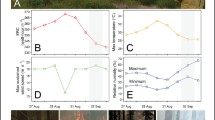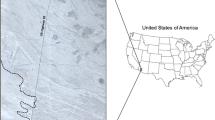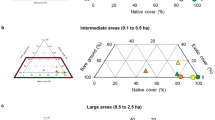Abstract
Woody encroachment in grasslands is a global phenomenon driven by complex interactions between climate, grazing and fire management. Alpine shrub encroachment is of particular concern for biological conservation because high-elevation grasslands harbor high levels of biodiversity and species endemism. Páramo grasslands of the high Andes are exceptionally high in floral diversity, but traditional agricultural practices have resulted in widespread livestock grazing and anthropogenic burning. Fire suppression has frequently been identified a driver of woody expansion in other grasslands, and conservation initiatives that aim to decrease burning and grazing in páramos may inadvertently lead to shrub encroachment. We tested whether interactions among fire and grazing legacies, topography and edaphic conditions predicted the patchy distribution of encroaching shrubs in an Ecuadorian páramo 10 years after release from burning and grazing. Interviews with land-users identified proximity to roads, footpaths and riparian areas as proxies for fire frequency and grazing pressure. A recursive partitioning model of shrub cover revealed that woody abundance was generally lower at lower elevations, especially near the access road (where fire frequency and grazing pressure were high). Within the low-elevation areas, shrub cover was highest near streams (where grazing pressure was high). These results suggest that (1) the effects of fire and grazing legacies depend on the spatial patterns of grazing, and (2) legacy effects interact with topography to help explain patchy shrub encroachment.





Similar content being viewed by others
References
Altesor A, Pineiro G, Lezama F et al (2006) Ecosystem changes associated with grazing in subhumid South American grasslands. J Veg Sci 17:323–332
Anthelme F, Villaret J, Brun J (2007) Shrub encroachment in the Alps gives rise to the convergence of sub-alpine communities on a regional scale. J Veg Sci 18:355–362
Archer S (1995) Tree–grass dynamics in a Prosopis—thornscrub savanna parkland: reconstructing the past and predicting the future. Ecoscience 2:83–99
Archibald S, Lehman C, Gómez-Dans J, Bradstock R (2013) Defining pyromes and global syndromes of fire regimes. PNAS 110:6442–6447
Bader M, Rietkerk M, Bregt A (2007) Vegetation structure and temperature regimes of tropical alpine treelines. Arct Antarct Alp Res 39:353–364
Beltrán K, Salgado S, Cuesta F, León-Yánez S, Romoleroux K, Ortiz E, Cárdenas A, Velástegui A (2009) Distribución Espacial, Sistemas Ecológicos y Caracterización Florística de los Páramos en el Ecuador. EcoCiencia, Proyecto Páramo Andino y Herbario QCA. Quito, Ecuador
Black C (1965) Methods of soil analysis: part I physical and mineralogical properties. American Society of Agronomy, Madison
Blake G, Hartge K (2002) Bulk Density. In: Klute A (ed) Methods of soil analysis, Part 1. Physical and mineralogical methods. Soil Science Society of America, Inc., Madison, pp 363–375
Brandt J, Haynes M, Kuemmerle T, Waller D, Radeloff V (2013) Regime shift on the roof of the world: alpine meadows converting to shrublands in the southern Himalayas. Biol Conserv 158:116–127
Briggs JM, Knapp AK, Blair JM, Heisler JL, Hoch GA, Lett MS, McCarron K (2005) An ecosystem in transition: woody plant expansion into mesic grassland. BioScience 55:243–254
Brock W, Carpenter S (2010) Interacting regime shifts in ecosystems: implications for early warnings. Ecol Monogr 80(3):353–367
Browning D, Archer S (2011) Protection from livestock fails to deter shrub proliferation in a desert landscape with a history of heavy grazing. Ecol Appl 21:1629–1642
Buytaert W, Wyseure G, De Bièvre B, Deckers J (2005) The effects of land-use changes on the hydrological behavior of histic andosols in south Ecuador. Hydrol Process 19:3985–3997
Buytaert W, Celleri R, De Bievre B et al (2006) Human impact on the hydrology of the Andean páramos. Earth-Sci Rev 79:53–72
D’Odorico P, Okin G, Bestelmeyer B (2012) A synthetic review of feedbacks and drivers of shrub encroachment in arid grasslands. Ecohydrology 5:520–530
D’Odorico P, He Y, Collins S, DeWekker S, Engel V, Fuentes J (2013) Vegetation-microclimate feedbacks in woodland-grassland ecotones. Glob Ecol Biogeogr 22:364–379
Dahlgren R, Vogt K, Ugolini F (1991) The influence of soil chemistry on fine root aluminum concentrations and root dynamics in subalpine Spodosol, Washington State, USA. Plant Soil 133:117–129
De Bievre B, Calle T (2011) The Andean páramo project: conserving biodiversity and hydrological services on the roof of the Andes. In: Mountain forum bulletin 2011: mountains and green economy, CONDESAN, Quito, Ecuador. http://www.condesan.org/ppa. Accessed Apr 2011
EcoCiencia (2009) Plan de Manejo y Desarrollo de la Comuna Zuleta. Proyecto Páramo Andino. Conservación de la Diversidad en el Techo de los Andes, Quito, Ecuador
Eldridge D, Bowker M, Maestre F, Roger E, Reynolds J, Whitford W (2011) Impacts of shrub encroachment on ecosystem structure and functioning: towards a global synthesis. Ecol Lett 14:709–722
ERSDAC (Earth Remote Sensing Data Analysis Center) (2007) of Japan, ASTER scene ASTL1A_0702051543490702090520, 1A, ASTER GDS IMS, http://imsweb.aster.ersdac.or.jp/ims/html/DPR/DPR_Menu.html. Accessed Apr 2011
ESRI (2011) ArcGIS desktop: release 10. Environmental Systems Research Institute, Redlands
Farley K, Anderson W, Bremer L, Harden C (2011) Compensation for ecosystem services: an evaluation of efforts to achieve conservation and development in Ecuadorian páramo grasslands. Environ Conserv 38:393–405
Fuhlendorf S, Archer S, Smeins F, Engle D, Taylor Jr C (2008) From the Dust Bowl to the Green Glacier: human activity and environmental change in Great Plains grasslands. In: Van Auken O (ed) Western North American Juniperus communities: a dynamic vegetation type. Springer, New York, pp 219–238
Heiri O, Lotter A, Lemcke G (2001) Loss on ignition as a method for estimating organic and carbonate content in sediments: reproducibility and comparability of results. J Paleolimnol 25:101–110
Hernandez Z, Monasterio M (2006) Functional diversity of wetland vegetation in the high-Andean páramo, Venezuela. In: Spehn E, Liberman M, Körner C (eds) Land use change and mountain biodiversity. CRC Press Group, Boca Raton, pp 187–197
Hofstede R, Coppus R, Mena VP, Segarra P, Wolf J, Sevink J (2002) The conservation status of tussock grass páramo in Ecuador (El estado de conservación de los páramos de pajonal en el Ecuador). Ecotropicos 15:3–18
Janzen D (1973) Rate of regeneration after a tropical high elevation fire. Biotropica 5:117–122
Jørgensen P, Ulloa C (1994) Seed plants of the high Andes of Ecuador: a checklist. AAU Rep 34:1–443
Knapp A, Briggs J, Collins S (2008) Shrub encroachment in North American grasslands: shifts in growth form dominance rapidly alters control of ecosystem carbon inputs. Glob Chang Biol 14:615–623
Korner C (1999) Alpine plant life: functional plant ecology of high mountain ecosystems. Springer, Berlin
Laegaard S (1992) Influence of fire in the grass páramo vegetation of Ecuador. In: Balsev H, Luteyn J (eds) Páramo: an Andean ecosystem under human influence. Academic Press, London, pp 151–170
Lett M, Knapp A (2003) Consequences of shrub expansion in mesic grassland: resource alterations and graminoid responses. J Veg Sci 14(4):487–496
Luteyn J (1992) Páramos: Why study them? In: Balslev H, Luteyn J (eds) Páramo: an Andean ecosystem under human influence. Academic Press Limited, U.K, pp 1–14
Luteyn J (1999) Páramos: a checklist of plant diversity, geographical distribution, and botanical literature. Memoirs of New York Botanical Garden 84. New York Botanical Garden Press, New York
Luteyn J, Churchill S (2000) Vegetation of the tropical Andes: an overview. In: Lentz D (ed) Imperfect balance: landscape transformations in the Precolombian Americas. The Historical Ecology Series. University Press, New York, pp 281–310
Marschner H (1991) Mechanisms of adaptations of plants to acid soils. Plant Soil 134:1–20
Matson E (2012) Shrub cover, community composition and diversity in post-agricultural páramo grasslands of the high Andes. Dissertation, University of Wisconsin, Madison
McCune B, Grace J (2002) Analysis of ecological communities. MjM Software Design, Gleneden Beach
Montane F, Rovira P, Casals P (2007) Shrub encroachment into mesic mountain grasslands in the Iberian peninsula: effects of plant quality and temperature on soil C and N stocks. Glob Biogeochem Cycles 21: GB4016
Myers N, Mittermeir R, Mittermeir C, da Fonseca G, Kent J (2000) Biodiversity hotspots for conservation priorities. Nature 403:853–858
Pendergrass K, Miller P, Kaufmann J (1998) Prescribed fire and the response of woody species in Willamette Valley wetland prairies. Restor Ecol 6:303–311
Pocknee S, Sumner M (1997) Cation and nitrogen contents of organic matter determine its soil liming potential. Soil Sci Soc Am J 61:86
Podwojewski P, Poulenard J, Zambrana T, Hofstede R (2002) Overgrazing effects on vegetation cover and properties of volcanic ash soil in the páramo of Llangahua and La Esperanza (Tungurahua, Ecuador). Soil Use Manage 18:45–55
R Development Core Team (2011) R: a language and environment for statistical computing. R Foundation for Statistical Computing, Vienna, Austria. ISBN 3-900051-07-0. http://www.R-project.org/. Accessed Sept 2011
Ramsay P, Oxley E (1996) Fire temperatures and postfire plant community dynamics in Ecuadorian grass páramo. Vegetation 124(2):129–144
Ramsay P, Oxley E (1997) The growth form composition of plant communities in the Ecuadorian páramos. Plant Ecol 131(2):173–192
Ratajczak Z, Nippert J, Hartman J, Ocheltree T (2011) Positive feedbacks amplify rates of woody encroachment in mesic tallgrass prairies. Ecosphere 2(11):121
Ratajczak Z, Nippert J, Collins S (2012) Woody encroachment decreases diversity across North American grasslands and savannas. Ecology 93(4):697–703
Roques K, O’Connor T, Watkinson A (2001) Dynamics of shrub encroachment in an African savanna: relative influences of fire, herbivory, rainfall, and density dependence. J App Ecol 38:268–280
Rouget M, Richardson D, Milton S, Polakow D (2004) Predicting invasion dynamics of four alien Pinus species in a highly fragmented semi-arid shrubland in South Africa. Plant Ecol 152:79–92
Salick J, Zhendong F, Byg A (2009) Eastern Himalayan alpine plant ecology, Tibetan ethnobotany, and climate change. Glob Environ Chang 19:147–155
Sarmiento L, Llambi L, Escalona A et al (2003) Vegetation patterns, regeneration rates and divergence in an old-field succession of the high tropical Andes. Plant Ecol 166:63–74
Sklenar P, Jorgenson P (2004) Distribution patterns of páramo plants in Ecuador. J Biogeo 26:681–691
Smith J, Cleef A (1988) Composition and origins of the world’s tropic alpine floras. J Biogeog 15:631–645
Southgate D, Wunder S (2007) Paying for watershed services in Latin America: a review of current initiatives (working paper no. 07-07). Sustainable Agriculture and Natural Resources Management Collaborative Research Support Program (SANREM CRSP) and Office of International Research, Education, and Development, Virginia Tech, USAID
Sturm M, Schimel J, Michaelson G, Welker J, Obersauer S, Liston G, Fahnestock J, Romaovsky V (2005) Winter biological processes could help convert arctic tundra to shrubland. Bioscience 55:17–26
Suarez E, Medina G (2001) Vegetation structure and soil properties in Ecuadorian páramo grasslands with different histories of burning and grazing. Arct Antarct Alp Res 33:158–164
Therneau T, Atkinson, E (1997) An Introduction to recursive partitioning: using the RPART routines. Technical Report 61, Mayo Clinic, Section of Statistics
Van Auken O (2000) Shrub invasions of North American semiarid grasslands. Annu Rev Ecol Syst 31:197–215
Van Wilgen B, Trollope W, Biggs H, Potgeiter A, Brockett B (2003) Fire as a driver of ecosystem variability. In: Du Toit J, Rogers K, Biggs H (eds) The Kruger experience: ecology and management of savanna heterogeneity. Island Press, Washington, DC, pp 149–170
Vayssieres M, Plant R, Allen-Diaz B (2000) Classification trees: an alternative non-parametric approach for predicting species distributions. J Veg Sci 11:679–694
Verweij P (1995) Spatial and temporal modeling of vegetation patterns: burning and grazing in the páramo of Los Nevados National Park, Colombia. Dissertation, International Institute for Aerospace Survey and Earth Sciences
Wille M, Hooghiemstra H, Hofstede R, Fehse J, Sevink J (2002) Upper forest line reconstruction in a deforested area in northern Ecuador based on pollen and vegetation analysis. J Trop Ecol 18:409–440
Wu Z, Sun H, Zhoa Z, Peng H, Li D (2007) Origin and differentiation of endemism in the flora of China. Front Biol China 2:125–143
Zavaleta E, Kettley L (2006) Ecosystem change along a woody invasion chronosequence in a California grassland. J Arid Environ 66:290–306
Acknowledgments
We thank the community of Zuleta, CONDESAN and EcoCiencia for facilitating our research at the study site. Zuleta community members provided valuable assistance in the interviews and field survey. Funding was provided to Emily Matson by the Doris Duke Foundation, the Nave Foundation, and the Department of Agronomy and the Gaylord Nelson Institute for Environmental Studies at the University of Wisconsin—Madison.
Author information
Authors and Affiliations
Corresponding author
Rights and permissions
About this article
Cite this article
Matson, E., Bart, D. Interactions among fire legacies, grazing and topography predict shrub encroachment in post-agricultural páramo . Landscape Ecol 28, 1829–1840 (2013). https://doi.org/10.1007/s10980-013-9926-5
Received:
Accepted:
Published:
Issue Date:
DOI: https://doi.org/10.1007/s10980-013-9926-5




